Today at GraphConnect we are demonstrating the new release of our graph visualization software Linkurious. Called “Tragicomical Toucan”, it is the first production-ready version. Linkurious is available in two flavors: Starter and Enterprise.
When it comes to communicate results visually, users of Linkurious Enterprise can already download static images in PNG or SVG formats. Now they can publish interactive visualizations online. Published visualizations can be accessed with an URL or embedded in a web page à la Google Maps. They contain a snapshot of graph data at the time the visualization is published. The visualization author can update or unpublish his visualizations anytime.
Anyone can explore these visualizations interactively, enabling easier collaboration around graph data. Users can optionally add a search bar, zoom buttons and more to the published visualization. An automatic legend will be available soon.

Widget example on Tesla Motors here
If the server that hosts Linkurious Enterprise is accessible via intranet only, published visualizations will be available within the organization and won’t be available outside.
Parallel edges are multiple edges between the same two nodes. We display them as curved edges with an arrow to represent the direction. This feature is fully automatic.
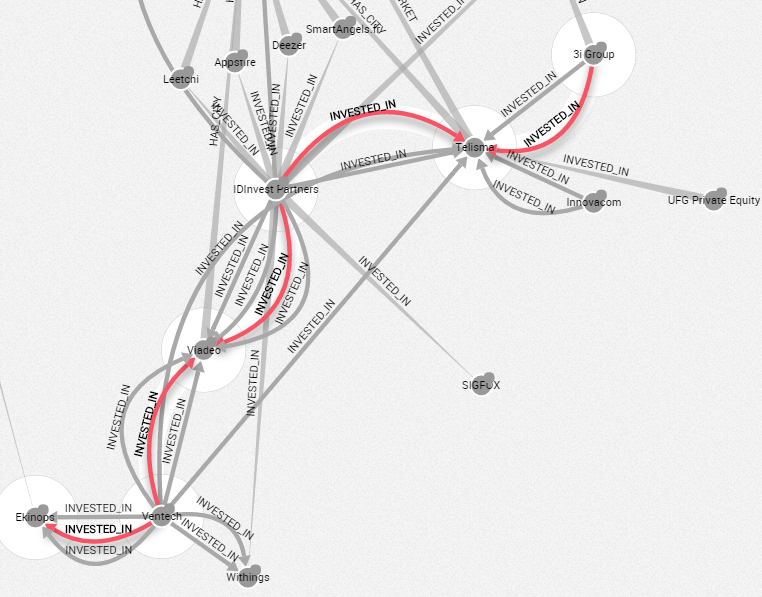
Linkurious users can collaborate on a shared visualization without publishing it. Similar to the experience of writing a blog post in WordPress, only a single user can edit a visualization at the same time. Other users will thus explore the visualization in read only mode. They can take over the visualization to become editors.

Jean’s dashboard. Seb has shared a visualization with him with the right to modify it.
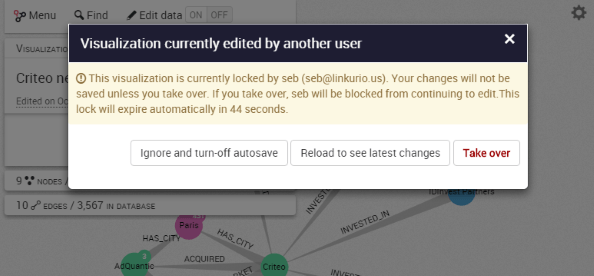
Jean has opened the visualization, but Seb it still editing it and the visualization is locked. Jean can explore it in read-only or take control of it.
New databases can be configured through the web interface as soon as Linkurious connects to them. Administrators can make each node or edge property key available or not to Linkurious users. They can also configure which properties will be searchable before indexing the database for the first time.
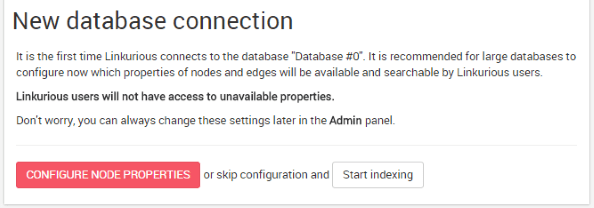
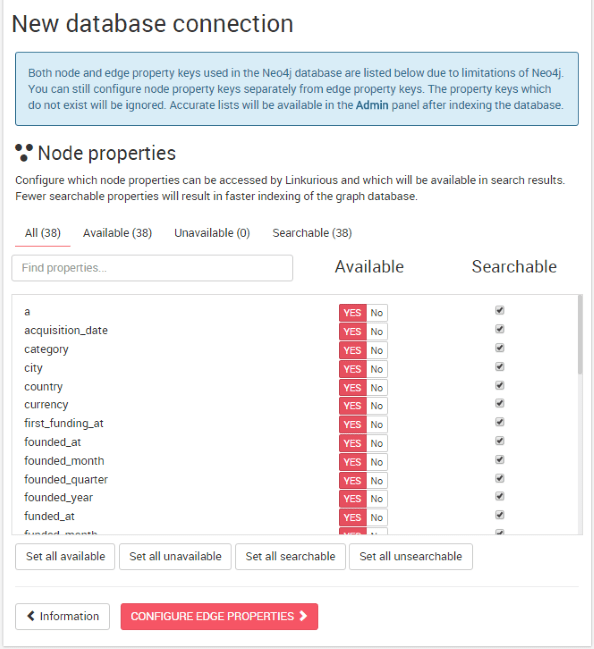
Linkurious now helps administrators seamlessly update to the latest version without losing their security setting and visualizations: download the latest version of Linkurious and save it to the Linkurious folder, then restart Linkurious. It will update the current installation of Linkurious and upgrade the internal database used by Linkurious to store specific data such as visualizations and user accounts.
If something wrong happens during the process, the upgrade is cancelled and the administrator gets information to fix the issue. However the system is not bullet-proof, so administrators should always backup Linkurious before proceeding to any upgrade. More information in the manual.
Administrators can now enable the generation of an audit trail of read and write operations into the graph database for operations made by Linkurious users. The goal is to log which operation was done by whom and when. This feature is disabled by default. The output is a set of files, written in the data/audit-trail folder. Files contain one operation per line as a JSON object.
Notice that operations must be triggered through the Linkurious API and direct accesses to graph databases are not recorded. Cypher operations are not recorded and must be disallowed for Linkurious users to guarantee the completeness of the audit trail.
Sample:
{"mode":"READ","date":"2015-10-11T11:05:21.888Z","user":"seb@linkurious.com","sourceKey":"2c08a4d9","action":"getEdge","params":{"edgeId":23}}
{"mode":"READ","date":"2015-10-11T11:05:21.889Z","user":"jean@linkurious.com","sourceKey":"2c08a4d9","action":"getNode","params":{"id":157}}
{"mode":"READ","date":"2015-10-11T11:05:21.910Z","user":"seb@linkurious.com","sourceKey":"2c08a4d9","action":"getNode","params":{"id":832}}
Linkurious is now easier to integrate with third-party applications. We are introducing the possibility to create a new visualization through a simple URL. Upon clicking on this URL, users will directly access a new visualization populated with a node, an edge, or a subgraph. Examples of URLs:
- Open a vis with the node of id “42”:
http://127.0.0.1:3000/workspace/new?populate_type=node&populate_id=42- Open a vis with the edge of id “42”:
http://127.0.0.1:3000/workspace/new?populate_type=edge&populate_id=42- Open a vis with the result of a search query that matches "foo*":
http://127.0.0.1:3000/workspace/new?populate_type=node&populate_query=foo*The ID of nodes and edges are store IDs. The support of external keys is planned for a future release. Using a Cypher query in URL will be available in a future release.
New visualizations are now created with the (color and size) style and caption choices used when creating the previous visualization during the same user session. If these information are not available, the style configured by default is applied.
Users of previous versions could end with dozens of “Untitled Visualizations” in their Dashboard because they use Linkurious a lot for searching their database. This issue is now fixed: users should click on a “Save” button to explicitely save newly created visualizations into their Dashboard if they want to. Users are asked to save new visualizations when they try to go back to their Dashboard. We also prevent accidental page refresh.
Notice that changes that happen after saving a visualization are continuously saved on background.
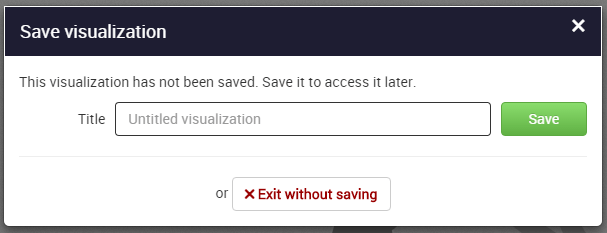
Linkurious speeds up graph data creation and edit. It now validates the data types (e.g. number, date, text, etc.) of nodes and edges properties regarding existing values in the database. For instance, users cannot enter the string “foo” as value of the property “age” if other values are numbers.
Linkurious will also suggests the properties of new nodes and edges based on their categories. For instance, if a new node is of category “Person”, Linkurious will suggest to fill the properties “gender”, “age”, “sex” that are used in the database to describe the nodes of category “Person”.
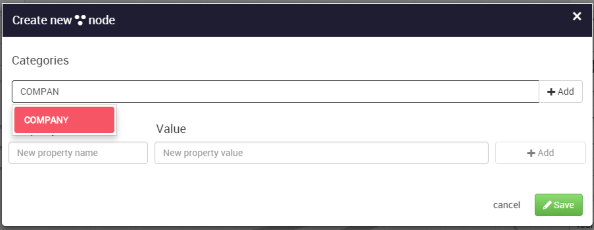
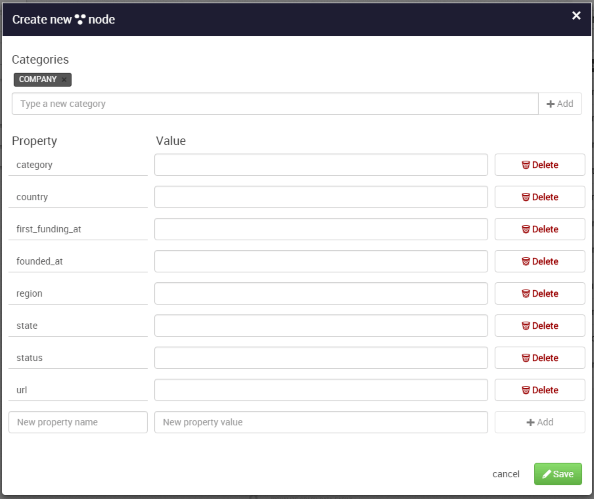
Other improvements include:
- Support of Active Directory for user authentication (Enterprise only).
- Prevent user multi-login sessions (Enterprise only).
- More robust management of multiple data sources through the user interface, handling connection errors and misconfiguration.
- Data sources can be named in the configuration file to manage them more easily through the user interface.
Since we started Linkurious in 2013, we have worked with dozens of Neo4j users around world to help them find answers in graph data. We have seen organizations struggle with a few common problems:
- finding answers in graph data require specific interfaces;
- off the shelves data visualization and business intelligence solutions are not graph friendly;
- building and maintaining a custom solution is slow and costly;
We are on a mission to help professionals create, investigate, and communicate graph data more efficiently. We believe that out-of-the-box software can address a large majority of use cases, be it anti-money laundering, knowledge management, or impact analysis. Extracting concrete insights from graphs doesn’t require a PhD in data science if we supercharge people with the right tools. We tackle user interface design, integration and scalability challenges so that our customers focus on their expertise.
Linkurious v1.0 is a great step forward and we are excited to support our first customers going in production at the moment. We will focus our efforts in the coming year on the following improvements:
User Interface
– data templating to enforce a schema when creating databases from scratch
– undo/redo with interactive history of visualizations and data manipulation
– flexible display of the properties of nodes and edges
– re-design of the styles and filters panel
– new layouts and geographical maps
– automatic legend generator
Scalability
– support graphs of a billion nodes and edges
– continuous indexing of graph data
– faster generation of database real schema and detection of anomalies
Integration
– support robust database re-generation by relying on external keys instead of store IDs of nodes and edges
– manage multiple data sources from the user interface
– support other graph databases through the Gremlin API and support other data stores (RDF, relational, key-value and column stores)
– Windows install as a service
– server web hooks
This list will evolve according to your feedback. Please contact us to discuss your needs!
A spotlight on graph technology directly in your inbox.